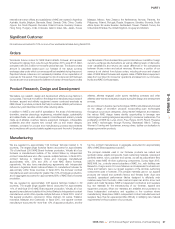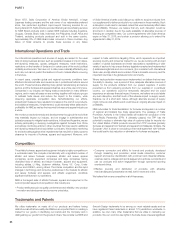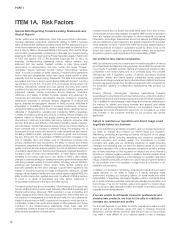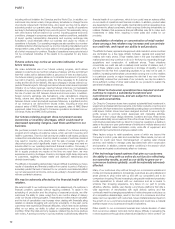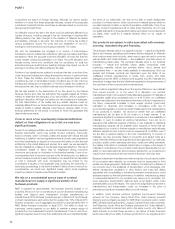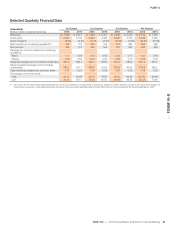Nike 2015 Annual Report Download - page 15
Download and view the complete annual report
Please find page 15 of the 2015 Nike annual report below. You can navigate through the pages in the report by either clicking on the pages listed below, or by using the keyword search tool below to find specific information within the annual report.PART I
The sale of a large number of shares of common stock
owned or managed by our Chairman and related entities
could depress the market price of our common stock.
As of June 30, 2015, Philip H. Knight, Co-founder and Chairman of our Board
of Directors, and Swoosh, LLC, an entity formed to manage 128,500,000
shares of Class A Common Stock formerly owned by Mr. Knight, beneficially
owned more than 82% of our Class A Common Stock. If on June 30, 2015 all
of the aforementioned Class A Common Stock were converted into Class B
Common Stock, the commensurate ownership percentage of our Class B
Common Stock would be approximately 17.7%. The Class A Common Stock
shares are available for resale, subject to the requirements of the U.S. securities
laws and the terms of the limited liability company agreement governing
Swoosh, LLC. The sale or prospect of the sale of a substantial number of these
shares could have an adverse effect on the market price of our common stock.
Changes in our credit ratings or macroeconomic
conditions may affect our liquidity, increasing borrowing
costs and limiting our financing options.
Our long-term debt is currently rated investment grade by Standard & Poor’s
and Moody’s Investors Service. If our credit ratings are lowered, borrowing
costs for future long-term debt or short-term credit facilities may increase and
our financing options, including our access to the unsecured credit market,
could be limited. We may also be subject to restrictive covenants that would
reduce our flexibility to, among other things, incur additional indebtedness,
make restricted payments, pledge assets as security, make investments,
loans, advances, guarantees and acquisitions, undergo fundamental
changes and enter into transactions with affiliates. Failure to comply with such
covenants could result in a default, and as a result, the commitments of our
lenders under our credit agreements may be terminated and the maturity of
amounts owed may be accelerated. In addition, macroeconomic conditions,
such as increased volatility or disruption in the credit markets, could adversely
affect our ability to refinance existing debt.
If our internal controls are ineffective, our operating results
could be adversely affected.
Our internal control over financial reporting may not prevent or detect
misstatements because of its inherent limitations, including the possibility of
human error, the circumvention or overriding of controls or fraud. Even
effective internal controls can provide only reasonable assurance with respect
to the preparation and fair presentation of financial statements. If we fail to
maintain the adequacy of our internal controls, including any failure to
implement required new or improved controls, or if we experience difficulties
in their implementation, our business and operating results could be harmed
and we could fail to meet our financial reporting obligations.
If our estimates or judgments relating to our critical
accounting policies prove to be incorrect, our operating
results could be adversely affected.
The preparation of financial statements in conformity with U.S. GAAP requires
management to make estimates and assumptions that affect the amounts
reported in the consolidated financial statements and accompanying notes.
We base our estimates on historical experience and on various other
assumptions that we believe to be reasonable under the circumstances, as
provided in “Management’s Discussion and Analysis of Financial Condition
and Results of Operations.” The results of these estimates form the basis for
making judgments about the carrying values of assets, liabilities and equity,
and the amount of revenue and expenses that are not readily apparent from
other sources. Significant assumptions and estimates used in preparing our
consolidated financial statements include those related to revenue
recognition, allowance for uncollectible accounts receivable, inventories,
contingent payments under endorsement contracts, accounting for property,
plant and equipment and definite-lived assets and goodwill and indefinite-
lived intangible assets. Our operating results may be adversely affected if our
assumptions change or if actual circumstances differ from those in our
assumptions, which could cause our operating results to fall below the
expectations of securities analysts and investors, resulting in a decline in the
price of our Class B Common Stock.
Anti-takeover provisions may impair an acquisition of the
Company or reduce the price of our common stock.
There are provisions of our articles of incorporation and Oregon law that are
intended to protect shareholder interests by providing the Board of Directors
a means to attempt to deny coercive takeover attempts or to negotiate with a
potential acquirer in order to obtain more favorable terms. Such provisions
include a control share acquisition statute, a freeze-out statute, two classes of
stock that vote separately on certain issues, and the fact that holders of
Class A Common Stock elect three-quarters of the Board of Directors
rounded down to the next whole number. However, such provisions could
discourage, delay or prevent an unsolicited merger, acquisition or other
change in control of our company that some shareholders might believe to be
in their best interests or in which shareholders might receive a premium for
their common stock over the prevailing market price. These provisions could
also discourage proxy contests for control of the Company.
We may fail to meet market expectations, which could
cause the price of our stock to decline.
Our Class B Common Stock is traded publicly, and at any given time various
securities analysts follow our financial results and issue reports on us. These
reports include information about our historical financial results as well as
analysts’ estimates of our future performance. Analysts’ estimates are based
upon their own opinions and are often different from our estimates or
expectations. If our operating results are below the estimates or expectations
of public market analysts and investors, our stock price could decline. In the
past, securities class action litigation has been brought against NIKE and
other companies following a decline in the market price of their securities. If
our stock price is volatile, we may become involved in this type of litigation in
the future. Any litigation could result in substantial costs and a diversion of
management’s attention and resources that are needed to successfully run
our business.
76



